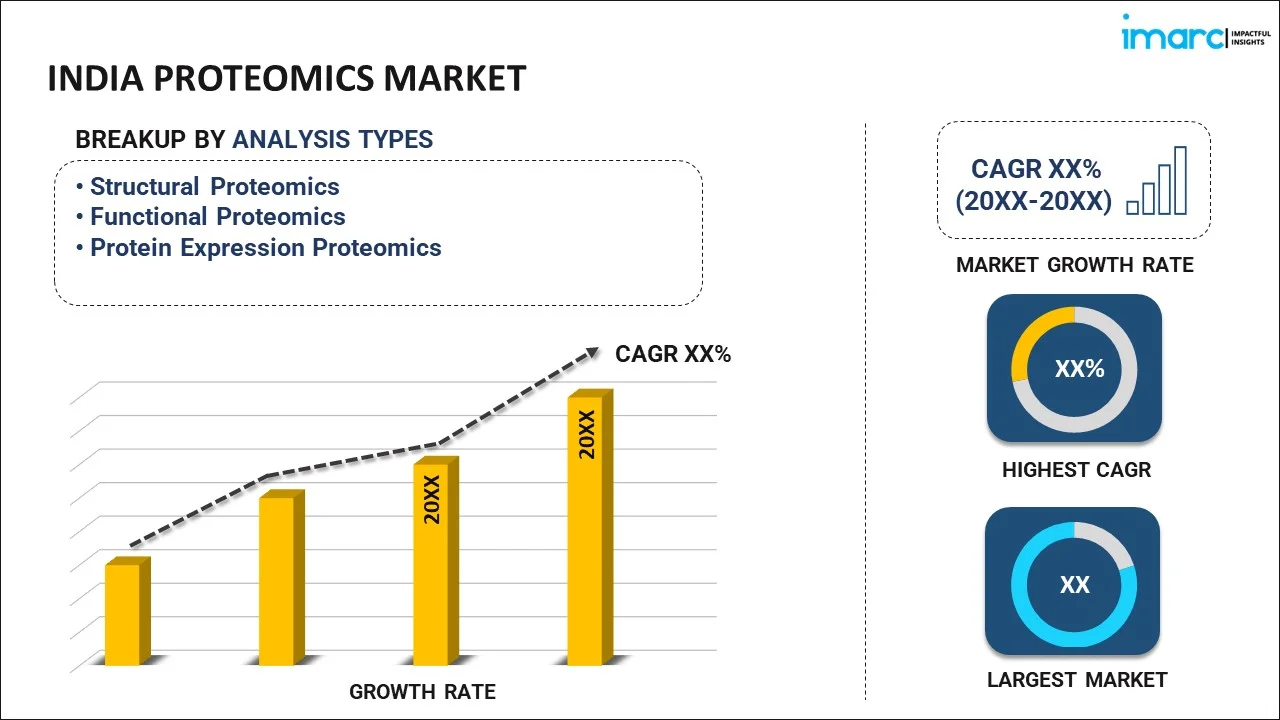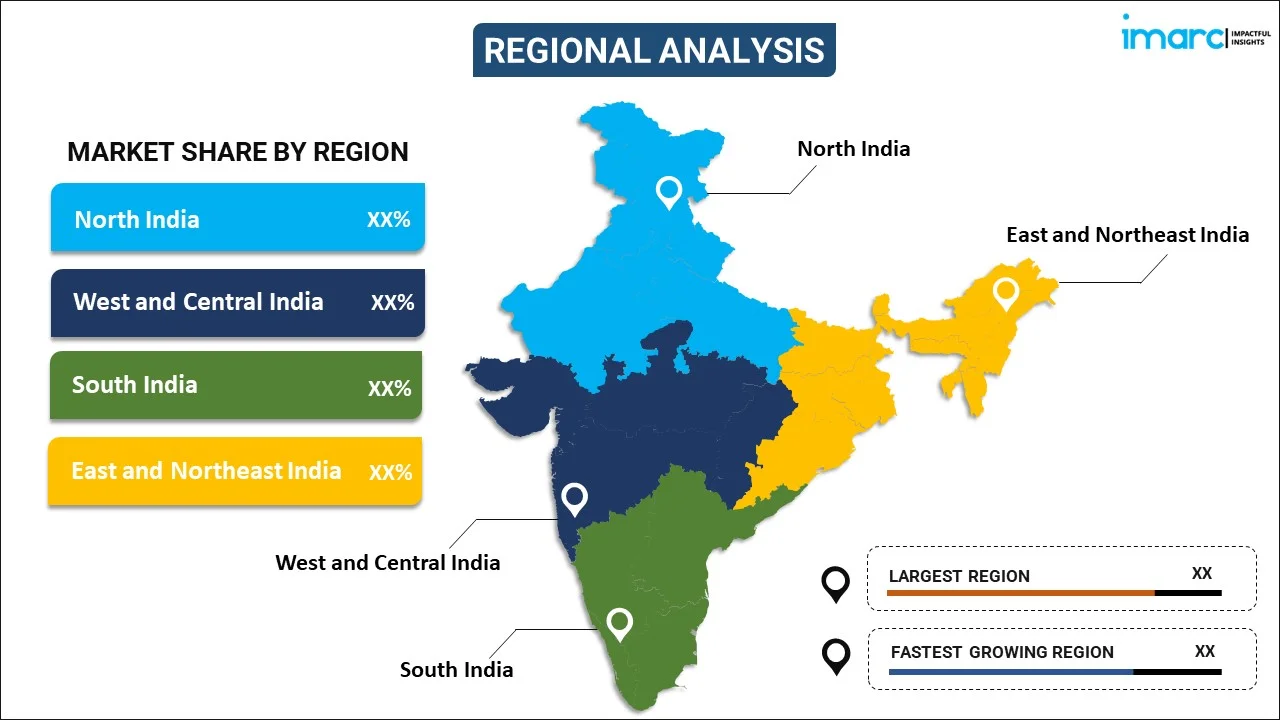
India Proteomics Market Report by Analysis Type (Structural Proteomics, Functional Proteomics, Protein Expression Proteomics), Component Type (Core Proteomics Services, Bioinformatics Software and Related Services), Technology (Spectroscopy, Chromatography, Electrophoresis, Protein Microarrays, X-Ray Crystallography, Surface Plasmon Resonance, and Others), Application (Protein Expression Profiling, Proteome Mining, Post-translational Modifications), End User (Clinical Diagnostic Laboratories, Research Organizations (Drug Discovery), and Others), and Region 2025-2033
Market Overview:
India proteomics market size reached USD 1,356.5 Million in 2024. Looking forward, IMARC Group expects the market to reach USD 2,792.2 Million by 2033, exhibiting a growth rate (CAGR) of 8.4% during 2025-2033. Improving healthcare outcomes that can aid in identifying cancer therapies and treatments are primarily driving the market growth across the country.
|
Report Attribute
|
Key Statistics
|
|---|---|
|
Base Year
|
2024
|
|
Forecast Years
|
2025-2033
|
|
Historical Years
|
2019-2024
|
| Market Size in 2024 | USD 1,356.5 Million |
| Market Forecast in 2033 | USD 2,792.2 Million |
| Market Growth Rate 2025-2033 | 8.4% |
Proteomics is the investigation of proteomes, exploring their extensive structure and physiological roles. This field delves into the changes and adaptations occurring in a given protein under diverse conditions. Utilizing diverse technologies, proteomics quantifies and identifies proteins, detects diagnostic markers, comprehends cellular pathogens, and interprets protein pathways related to various diseases. It assesses protein production rates and interaction patterns, making it highly valuable in drug discovery and the creation of personalized medications.
India Proteomics Market Trends:
The India proteomics market has witnessed significant growth and development in recent years, reflecting the expanding scope and applications of proteomic technologies in various sectors. One key aspect of the market is its role in advancing medical research and healthcare. Additionally, researchers and healthcare professionals in India are leveraging proteomic technologies to identify and analyze proteins associated with different diseases, facilitating early detection and targeted treatment strategies. This approach not only enhances patient outcomes but also contributes to the optimization of healthcare resources. Moreover, the pharmaceuticals industry in India has recognized the potential of proteomics in drug discovery and development. By employing proteomic techniques, researchers can gain insights into the complex interactions of proteins, identify potential drug targets, and optimize therapeutic interventions. Furthermore, this has led to an increased integration of proteomics in the drug development pipeline, aligning with the emerging trends in precision medicine. The India proteomics market is characterized by a growing number of research initiatives, collaborations, and investments in infrastructure and technology. Leading academic institutions, biotechnology companies, and research organizations are actively contributing to the expansion of proteomic research capabilities in the country. As a result, India is becoming a hub for innovative proteomic solutions, with a potential to make significant contributions to the landscape of life sciences and healthcare. Apart from this, the evolving ecosystem of the India proteomics market positions the country as a key player in advancing scientific knowledge, which is anticipated to fuel the market growth over the forecasted period.
India Proteomics Market Segmentation:
IMARC Group provides an analysis of the key trends in each segment of the market, along with forecasts at the country level for 2025-2033. Our report has categorized the market based on analysis type, component type, technology, application, and end user.
Analysis Type Insights:

- Structural Proteomics
- Functional Proteomics
- Protein Expression Proteomics
The report has provided a detailed breakup and analysis of the market based on the analysis type. This includes structural proteomics, functional proteomics, and protein expression proteomics.
Component Type Insights:
- Core Proteomics Services
- Bioinformatics Software and Related Services
A detailed breakup and analysis of the market based on the component type have also been provided in the report. This includes core proteomics services and bioinformatics software and related services.
Technology Insights:
- Spectroscopy
- Chromatography
- Electrophoresis
- Protein Microarrays
- X-Ray Crystallography
- Surface Plasmon Resonance
- Others
The report has provided a detailed breakup and analysis of the market based on the technology. This includes spectroscopy, chromatography, electrophoresis, protein microarrays, x-ray crystallography, surface plasmon resonance, and others.
Application Insights:
- Protein Expression Profiling
- Proteome Mining
- Post-translational Modifications
A detailed breakup and analysis of the market based on the application have also been provided in the report. This includes protein expression profiling, proteome mining, and post-translational modifications.
End User Insights:
- Clinical Diagnostic Laboratories
- Research Organizations (Drug Discovery)
- Others
The report has provided a detailed breakup and analysis of the market based on the end user. This includes clinical diagnostic laboratories, research organizations (drug discovery), and others.
Regional Insights:

- North India
- West and Central India
- South India
- East and Northeast India
The report has also provided a comprehensive analysis of all the major regional markets, which include North India, West and Central India, South India, and East and Northeast India.
Competitive Landscape:
The market research report has also provided a comprehensive analysis of the competitive landscape in the market. Competitive analysis such as market structure, key player positioning, top winning strategies, competitive dashboard, and company evaluation quadrant has been covered in the report. Also, detailed profiles of all major companies have been provided.
India Proteomics Market Report Coverage:
| Report Features | Details |
|---|---|
| Base Year of the Analysis | 2024 |
| Historical Period | 2019-2024 |
| Forecast Period | 2025-2033 |
| Units | Million USD |
| Scope of the Report | Exploration of Historical Trends and Market Outlook, Industry Catalysts and Challenges, Segment-Wise Historical and Future Market Assessment:
|
| Analysis Types Covered | Structural Proteomics, Functional Proteomics, Protein Expression Proteomics |
| Component Types Covered | Core Proteomics Services, Bioinformatics Software and Related Services |
| Technologies Covered | Spectroscopy, Chromatography, Electrophoresis, Protein Microarrays, X-Ray Crystallography, Surface Plasmon Resonance, Others |
| Applications Covered | Protein Expression Profiling, Proteome Mining, Post-translational Modifications |
| End Users Covered | Clinical Diagnostic Laboratories, Research Organizations (Drug Discovery), Others |
| Regions Covered | North India, West and Central India, South India, East and Northeast India |
| Customization Scope | 10% Free Customization |
| Post-Sale Analyst Support | 10-12 Weeks |
| Delivery Format | PDF and Excel through Email (We can also provide the editable version of the report in PPT/Word format on special request) |
Key Questions Answered in This Report:
- How has the India proteomics market performed so far and how will it perform in the coming years?
- What has been the impact of COVID-19 on the India proteomics market?
- What is the breakup of the India proteomics market on the basis of analysis type?
- What is the breakup of the India proteomics market on the basis of component type?
- What is the breakup of the India proteomics market on the basis of technology?
- What is the breakup of the India proteomics market on the basis of application?
- What is the breakup of the India proteomics market on the basis of end user?
- What are the various stages in the value chain of the India proteomics market?
- What are the key driving factors and challenges in the India proteomics?
- What is the structure of the India proteomics market and who are the key players?
- What is the degree of competition in the India proteomics market?
Key Benefits for Stakeholders:
- IMARC’s industry report offers a comprehensive quantitative analysis of various market segments, historical and current market trends, market forecasts, and dynamics of the India proteomics market from 2019-2033.
- The research report provides the latest information on the market drivers, challenges, and opportunities in the India proteomics market.
- Porter's five forces analysis assist stakeholders in assessing the impact of new entrants, competitive rivalry, supplier power, buyer power, and the threat of substitution. It helps stakeholders to analyze the level of competition within the India proteomics industry and its attractiveness.
- Competitive landscape allows stakeholders to understand their competitive environment and provides an insight into the current positions of key players in the market.
Need more help?
- Speak to our experienced analysts for insights on the current market scenarios.
- Include additional segments and countries to customize the report as per your requirement.
- Gain an unparalleled competitive advantage in your domain by understanding how to utilize the report and positively impacting your operations and revenue.
- For further assistance, please connect with our analysts.
 Inquire Before Buying
Inquire Before Buying
 Speak to an Analyst
Speak to an Analyst
 Request Brochure
Request Brochure
 Request Customization
Request Customization




.webp)




.webp)












